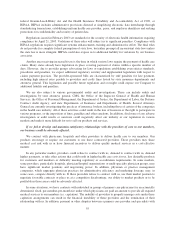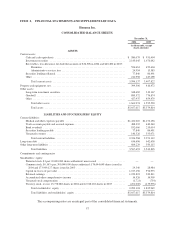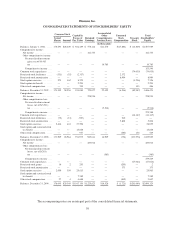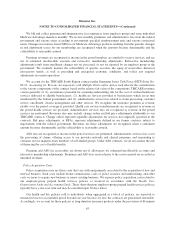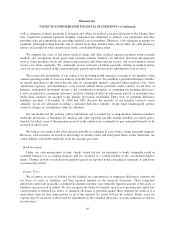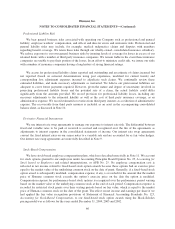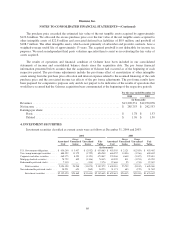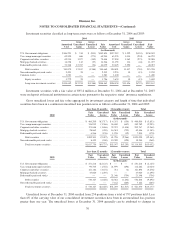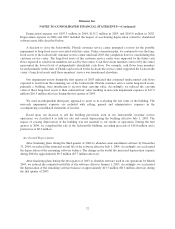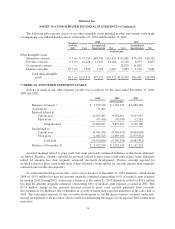Humana 2004 Annual Report Download - page 74
Download and view the complete annual report
Please find page 74 of the 2004 Humana annual report below. You can navigate through the pages in the report by either clicking on the pages listed below, or by using the keyword search tool below to find specific information within the annual report.Humana Inc.
NOTES TO CONSOLIDATED FINANCIAL STATEMENTS—(Continued)
of Financial Accounting Standards No. 60, Accounting and Reporting by Insurance Enterprises, or Statement 60.
As a result, we defer policy acquisition costs and amortize them over the estimated life of the policies in
proportion to premiums earned. Deferred acquisition costs are regularly reviewed to determine if they are
recoverable from future income.
Long-Lived Assets
Property and equipment is recorded at cost. Gains and losses on sales or disposals of property and
equipment are included in administrative expense. Certain costs related to the development or purchase of
internal-use software are capitalized in accordance with AICPA Statement of Position 98-1, Accounting for the
Costs of Computer Software Developed or Obtained for Internal Use. Depreciation is computed using the
straight-line method over estimated useful lives ranging from 3 to 10 years for equipment, 3 to 7 years for
computer software, and 20 to 40 years for buildings. Improvements to leased facilities are depreciated over the
shorter of the remaining lease term or the anticipated life of the improvement.
We periodically review long-lived assets, including property and equipment and other intangible assets, for
impairment whenever adverse events or changes in circumstances indicate the carrying value of the asset may not
be recoverable. Losses are recognized for a long-lived asset to be held and used in our operations when the
undiscounted future cash flows expected to result from the use of the asset are less than its carrying value. We
recognize an impairment loss based on the excess of the carrying value over the fair value of the asset. A long-
lived asset held for sale is reported at the lower of the carrying amount or fair value less costs to sell.
Depreciation expense is not recognized on assets held for sale. Losses are recognized for a long-lived asset to be
abandoned when the asset ceases to be used. In addition, we periodically review the estimated lives of all long-
lived assets for reasonableness.
Goodwill and Other Intangible Assets
Goodwill represents the unamortized excess of cost over the fair value of the net tangible and other
intangible assets acquired. Statement of Financial Accounting Standards No. 142, Goodwill and Other Intangible
Assets, or Statement 142, requires that we not amortize goodwill to earnings, but instead requires that we test at
least annually for impairment at a level of reporting referred to as the reporting unit and more frequently if
adverse events or changes in circumstances indicate that the asset may be impaired. A reporting unit is one level
below our Commercial and Government segments. The Commercial segment’s two reporting units consist of
health insurance and specialty products. The Government segment’s three reporting units consist of Medicare
Advantage, TRICARE and Medicaid. Goodwill is assigned to the reporting unit that is expected to benefit from a
specific acquisition.
Statement 142 requires a two-step process to review goodwill for impairment. The first step is a screen for
potential impairment, and the second step measures the amount of impairment, if any. Impairment tests are
performed, at a minimum, in the fourth quarter of each year supported by our long-range business plan and
annual planning process. Impairment tests completed for 2004, 2003 and 2002 did not result in an impairment
loss.
Other intangible assets primarily relate to acquired subscriber and provider contracts and are included with
other long-term assets in the consolidated balance sheets. Other intangible assets are amortized over the useful
life, generally using the straight-line method. We review other finite-lived intangible assets for impairment under
our long-lived asset policy.
Medical and Other Expenses Payable and Medical Cost Recognition
Medical costs include claim payments, capitation payments, pharmacy costs net of rebates, allocations of
certain centralized expenses and various other costs incurred to provide health insurance coverage to members, as
64



